Dog bites are the most common animal bite in America (Figure 1). A bite from a dog has a lower rate of infection than a bite from a cat. Dog bites will cause infection in about 2%-5% of cases. Cat bites, on the contrary, will cause infection in about 30% - 50% of cases.
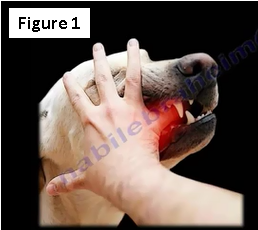
Dogs have very prominent teeth with powerful jaws and strong bite pressure (Figure 2). When large dogs attack, they tend to aim for the head and neck. Suspect that the animal is infected if the animal attack is unprovoked and also if they are showing bizarre behavior. Other causes of unprovoked attacks may include approaching the animal’s young, the animal is protecting their territory, coming near the animal while they are eating, or attempting to separate a fight between multiple animals.

Dog bites can cause extensive soft tissue damage. Their teeth tear and crush the soft tissue. These wounds are initially treated in the emergency room with local wound care, combined with antibiotics (Figure 3).
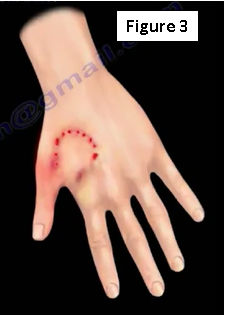
In some cases (rare) the crush injury is so severe that compartment syndrome may develop and the patient may need a fasciotomy, which is releasing the built up forearm pressure (Figure 4).
Dog bites cause structural damage, these bites affect the upper extremity more than the lower extremity. There is a delayed presentation and usually the injury and care is underestimated.
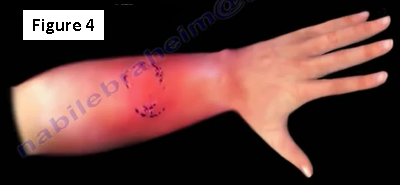
Interestingly, the dog is usually familiar with the victim in approximately 90% of cases (Figure 5). Most dogs will revert back to their normal, friendly behavior after an attack.

There are more dog bites than cat bites, or even human bites. Females are bitten more by cats while males are bitten more by dogs. Animal bites are also common among children.
Bacteria Associated with the Bite
Fifty percent of infections have a mixed bacterial flora. It is a combination of aerobic and anaerobic organisms. The average is about six different organisms.
Cat bites have a higher rate of infection. A cat has small, sharp, needle-like teeth that can puncture and cause deep wounds penetrating the joint and the flexor tendon sheath. The puncture wounds sometimes seal up immediately, becoming unnoticed or underestimated (not obvious) (Figure 6). It may take longer to for the symptoms to present.
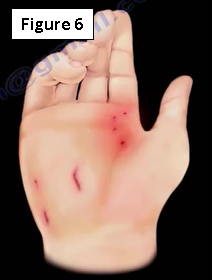
What causes infection in both dog and cat bites?
If the patient is older, infection can occur when the treatment is delayed for more than 12 hours or if it is a crush or puncture wound. If the patient has an underlying medical condition, such as diabetes or an immunosuppressed condition, their risk for infection drastically increases. In general, the bacteria for both dogs and cats is polymicrobial with more than one anaerobe (Figure 7).
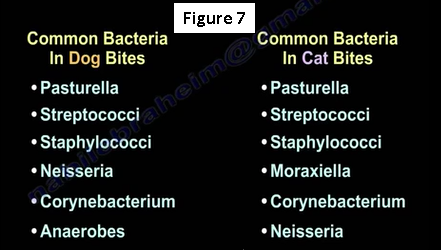
The most common bacteria isolated from both cat and dog bites is pasteurella. Pasteurella bacteria takes about a week to grow. Pasteurella is present in about 50% of dog bite infections and 80% of cat bite infections.
Treatment
If the patient is seen early on, the physician should irrigate the wound in the emergency room, and a tetanus toxoid vaccine should be administered. The patient will be given a splint and prescribed antibiotics. Local wound care and observation will also be utilized. If treatment is delayed, the patient may develop an infection such as an abscess, septic arthritis, tenosynovitis, or osteomyelitis (Figure 8). The patient will need to go to surgery for an incision and drainage.
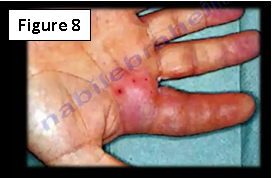
The physician can suture the wound primarily in facial wounds because this area is very rich in blood supply (Figure 9). Do a secondary closure in most of the wounds. Augmentin is the antibiotic that is commonly used for dog and cat bites. All cat bites should be covered with Augmentin regardless of the wound.
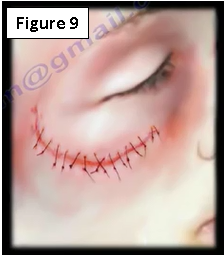
The use of iodine or soap may reduce the development of rabies if the animal is suspected to be infected. If the patient is suspected to have rabies, the patient will be given a vaccination and immunoglobulin (Figure 10).
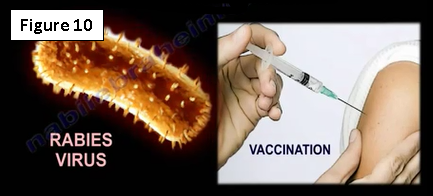
Cat Scratch Disease
Cat scratch disease is different. It is an infection that is transmitted by a cat’s scratch (Figure 11). The lesion is small, less than 1 cm, and is self-limited caused by exposure to bartonella henselae bacteria.
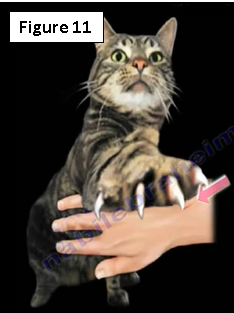
The patient may have swollen or draining lymph nodes (Figure 12). Other symptoms include fever, fatigue and headache. Swollen, tender lymph nodes could be confused with a tumor. Cat scratch disease is treated with antibiotics. No biopsy is needed for this condition.
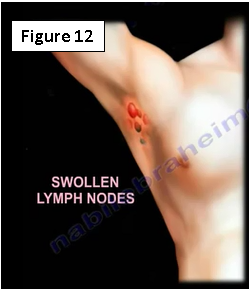
For more information, visit my YouTube Channel:
